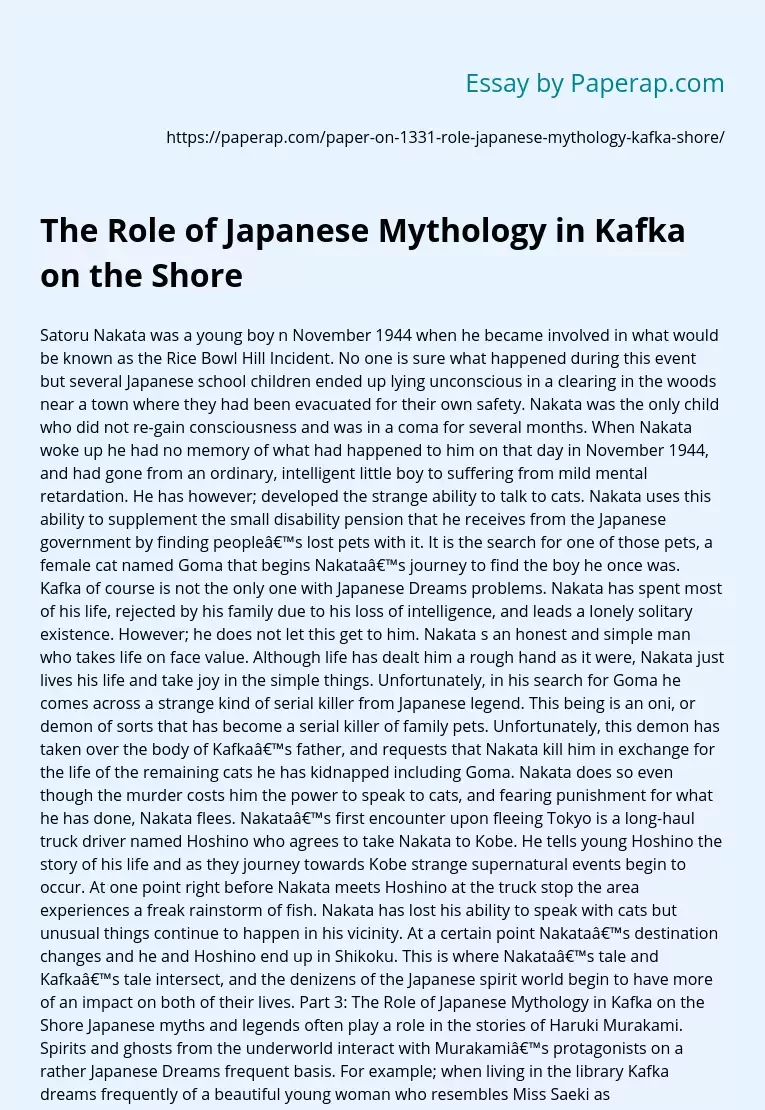Satoru Nakata was a young boy n November 1944 when he became involved in what would be known as the Rice Bowl Hill Incident. No one is sure what happened during this event but several Japanese school children ended up lying unconscious in a clearing in the woods near a town where they had been evacuated for their own safety. Nakata was the only child who did not re-gain consciousness and was in a coma for several months. When Nakata woke up he had no memory of what had happened to him on that day in November 1944, and had gone from an ordinary, intelligent little boy to suffering from mild mental retardation.
He has however; developed the strange ability to talk to cats. Nakata uses this ability to supplement the small disability pension that he receives from the Japanese government by finding people’s lost pets with it. It is the search for one of those pets, a female cat named Goma that begins Nakata’s journey to find the boy he once was.
Kafka of course is not the only one with Japanese Dreams problems. Nakata has spent most of his life, rejected by his family due to his loss of intelligence, and leads a lonely solitary existence. However; he does not let this get to him.
Nakata s an honest and simple man who takes life on face value. Although life has dealt him a rough hand as it were, Nakata just lives his life and take joy in the simple things.
Unfortunately, in his search for Goma he comes across a strange kind of serial killer from Japanese legend. This being is an oni, or demon of sorts that has become a serial killer of family pets. Unfortunately, this demon has taken over the body of Kafka’s father, and requests that Nakata kill him in exchange for the life of the remaining cats he has kidnapped including Goma.
Nakata does so even though the murder costs him the power to speak to cats, and fearing punishment for what he has done, Nakata flees. Nakata’s first encounter upon fleeing Tokyo is a long-haul truck driver named Hoshino who agrees to take Nakata to Kobe. He tells young Hoshino the story of his life and as they journey towards Kobe strange supernatural events begin to occur. At one point right before Nakata meets Hoshino at the truck stop the area experiences a freak rainstorm of fish.
Nakata has lost his ability to speak with cats but unusual things continue to happen in his vicinity. At a certain point Nakata’s destination changes and he and Hoshino end up in Shikoku. This is where Nakata’s tale and Kafka’s tale intersect, and the denizens of the Japanese spirit world begin to have more of an impact on both of their lives. Part 3: The Role of Japanese Mythology in Kafka on the Shore Japanese myths and legends often play a role in the stories of Haruki Murakami. Spirits and ghosts from the underworld interact with Murakami’s protagonists on a rather
Japanese Dreams frequent basis. For example; when living in the library Kafka dreams frequently of a beautiful young woman who resembles Miss Saeki as a young girl. He notices that the young woman floats above the ground rather than walks and never appears to notice him. (p 241, Kafka on the Shore; Vintage Paperbacks, 2005)To Kafka it seems that this is the piece of Miss Saeki’s soul that died when her high school sweetheart died tragically forever haunts the place where they once had such happy times.
The spirit world of Japanese legend also makes its appearance known in the beginning of Nakata’s tale when he encounters the feline serial killer that he calls Johnnie Walker (p 139-142; Kafka on the Shore: Vintage Paperbacks, 2005). Johnnie Walker resembles at least in personality the oni of Japanese legend. The oni are commonly thought of as ogres, devils, or demons depending on the translation.
The website of the Mukashibanashi Library (http://www. Mukashibanashi. org) describes oni as being either “wise and cunning, or slow and stupid depending on who is telling the tale. ” (p 1: Website Overview: (http://www. Mukashibanashi. org). Johnnie Walker most definitely fulfills the idea of an oni being “wise and cunning. ” He tricks Nakata into giving up his ability to speak to cats which seems reliant upon the innocence that he exudes due to his developmental disability. He then proceeds to push Nakata until Nakata picks up a kitchen knife and stabs him to death.
The Role of Japanese Mythology in Kafka on the Shore. (2017, May 26). Retrieved from https://paperap.com/paper-on-1331-role-japanese-mythology-kafka-shore/

